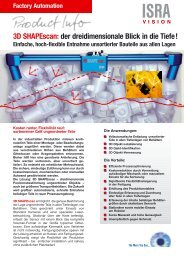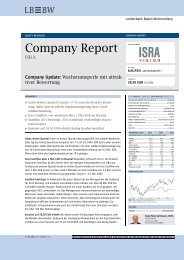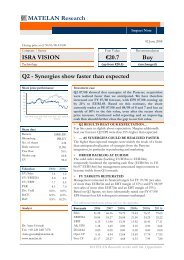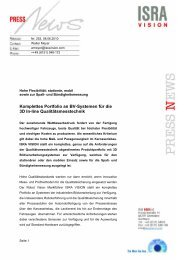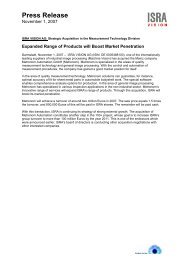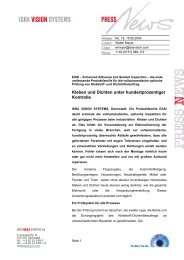MATELAN Research - ISRA VISION AG
MATELAN Research - ISRA VISION AG
MATELAN Research - ISRA VISION AG
You also want an ePaper? Increase the reach of your titles
YUMPU automatically turns print PDFs into web optimized ePapers that Google loves.
<strong>ISRA</strong> <strong>VISION</strong> In-Depth Report<br />
Automotive still on the<br />
expansion trail<br />
Glass market to show<br />
more moderate growth<br />
Metal benefiting from<br />
relocation of capacities<br />
Paper and pulp still off<br />
peak levels<br />
Pharma shows high<br />
growth from BRIC<br />
countries and new<br />
regulatory requirements<br />
Semiconductors growing<br />
at solid rate again<br />
- 14 -<br />
Going forward we see the automotive industry taking the dynamic<br />
development, which was predominantly driven by the four BRIC countries as<br />
well as the US market, into 2011 and (to a slightly lesser extent) 2012, though<br />
some European markets have cooled down somewhat. Investment spending<br />
appears to continue, mainly in order to serve upcoming demand in Asia, in<br />
particular China.<br />
In the flat glass industry, China accounts for approximately 50% of global flat<br />
glass production, followed by Europe (16% in 2009) and the US (8% in<br />
2009). In 2010, sales showed declines in some instances in building products,<br />
automotive as well as speciality glass. In 2011, the building sector now shows<br />
a return to modest growth, the solar business is expected to continue growing<br />
as are the automotive (see above) and display businesses. In fact, the glass<br />
market is expected to grow on average by 6% through 2014. However, 2012<br />
might be slightly below that rate and the industry might not come back to<br />
pre-crisis production levels before 2013. We would thus expect to see<br />
investments in machine vision systems rather as a result of productivity<br />
measures than further capacity expansions.<br />
The metal industry showed double-digit growth rates in all steel producing<br />
countries in 2010. Aluminium production increased mainly as a result of new<br />
smelters started and restarted, in particular in China but also Qatar and the<br />
UAE. Copper production remained roughly stable. Going forward,<br />
production might fall back again, leading to a lower utilisation of capacities.<br />
Still, there is a trend to relocate capacities to higher growth regions, which<br />
should be favourable for machine vision companies.<br />
The production of paper and pulp has recovered to some extent from the<br />
dramatic decline in 2009 but is still 8-10% short of the pre-crisis levels. The<br />
year 2011 is expected to show further progress in a mid-single digit rate. The<br />
industry should thus see its pre-crisis levels by 2012/13. Going forward, we<br />
would thus expect investment activity to accelerate moderately.<br />
The world pharmaceutical market was worth an estimated EUR597bn in<br />
2010, with North America accounting for a 42% share, well ahead of Europe<br />
(29%) and Japan (11%). Rapid growth is experienced in particular in<br />
emerging economies such as Brazil, China and India. China and Brazil<br />
showed growth rates of more than 20% compared with an average rate of<br />
1.8% in the five major European markets and 3.3% for the US market.<br />
Increasing regulatory requirements in many countries that aim at securing<br />
drug safety despite increasingly globalized supply chains should additionally<br />
fuel investment spending in track and tracing solutions. The European<br />
Parliament, for example, has adopted a directive against falsified medicine in<br />
February 2011, which must be implemented into national law until 2013.<br />
In the semiconductor industry, all major product categories showed doubledigit<br />
growth rates in 2010. With a 31.8% increase compared to the crisis year<br />
2009, the industry recorded a record number of global chip sales last year.<br />
With 54% of sales the Asia/Pacific region is the largest market for<br />
semiconductors. For 2011, a moderate single digit growth is expected, though<br />
the year has started with double-digit growth. Silicon wafers showed a slightly<br />
lower growth (45%) compared to chips in 2010 so that solid demand (at a<br />
more modest post-recovery rate) is expected for 2011. The global electric and<br />
electronic industry followed the recovery of the semiconductor and silicon<br />
wafer industry in 2010 and has compensated the losses during the global<br />
crisis within a year. For 2011, the world market is expected to grow by 7%,<br />
with the most dynamic development in the emerging markets. 2012 should<br />
come in slightly below this rate.



